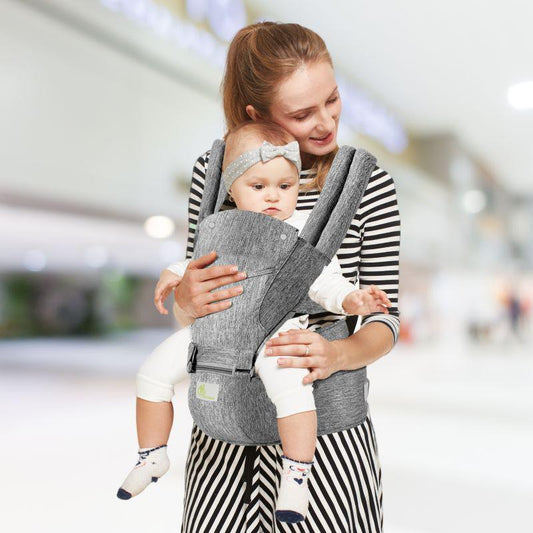How To Carry Your Baby In A Hassle-Free Manner With A Baby Carrier? 7 Tips

Imagine the need to hold onto your baby 24/7 to aid their constant fussiness and anxiety while you are laden with loads of work on the side! Tiresome, isn’t it!
The only solution to this constant validation was an age-old practice of slinging them across the mother’s body for their comfort and security.
We have usually witnessed such a depiction at a construction site. Also, Rani Lakshmi Bai was such an amazing example of the same.
Why Do Baby Carriers Help?
Babies feel safest in the womb due to the easier accessibility and familiarity of their mothers’ voices, touch, and smell.
However, their transition from the safest place on earth to the most chaotic world after birth comes with a challenge of constant care, affection, and security. Baby carriers, thus, become a source of their smooth transition into this world.
Apart from this, they also assist in many other ways in the overall growth and development of the child. This blog will help you understand everything about baby carriers and their safety guidelines, thus making them an important parenting assistant!
7 Tips For Carrying Your Baby Comfortably With Baby Carriers
Let us now discuss how to use a baby carrier safely, along with some important tips and guidelines for their optimum comfort.
I. Safety Guidelines For Babywearing
1. Ensure that the baby’s spine is naturally curved in an “M” position and provides optimum support from knee to knee. Also, avoid having a straight spine for them, as it forces the legs straight down.
2. Keep the baby’s face close enough to monitor them at all times and ensure that their airways aren’t blocked. Also, be sure to keep their head on your chest due to their easy accessibility to your heartbeat, and also to give them a peck regularly to make them feel secure.
3. Due to the inability of newborns to regulate their head movement, their position could sometimes also block their airways. Therefore, at least a finger’s width of space under their chin is necessary, and also avoid placing their chin on your chest for easy breathing.
4. Always ensure to snugly fit your child with a proper harness and avoid loose-fitting at all costs. Also, keep monitoring for the damaged parts, stress in the fabric, etc.
II. Tips for Comfortable Babywearing
5. Ensure you wear fitted clothing to provide a snug fit of the straps, buckles, and fastenings. Also check if the straps provide an even distribution of weight across the shoulders, back, and hips.
6. Dress yourself in lightweight, breathable, and comfortable clothing in summer to avoid overheating the baby.
Also, carry sun hats or light blankets to protect the baby from harmful radiation. On the other hand, in winter, wear snug layers to securely position your baby in the carrier.
7. It is important to self-practice the positioning of the baby in the carrier. Also, seek help until the tying comes naturally to you.
Tip: Practice the entire process with the doll in front of the mirror until you become perfect.
Choosing the Right Baby Carriers
To learn about how to carry a baby safely begins with making the right choice of baby carriers, which includes
1. Consider Baby's Age And Weight
Different carriers are designed for different age groups and weights. This is because of the physiological difference between different age groups.
For example, a newborn requires a carrier that provides a snug fit and ergonomic support for the head, neck, and torso. On the other hand, a toddler would specifically require just a comfortable seating space.
Also, it is important to seek an “M” position baby carrier to provide the right support for the baby’s essential growth and development.
2. Choose Adjustable Carriers
Babies tend to grow up very quickly due to their varying growth spurts in their initial years. This demands investment that could give long-term benefits.
For example, multi-position baby carriers are a great investment that could allow your baby to experience everything from a front-facing-in, front-facing-out, back carry, hip carry, etc.
This flexibility assists in providing them with an optimum environment and assisting them in their developmental milestone.
3. Seek Parents' Recommendations
Word of mouth is the strongest form of trust, especially when it comes to baby care.
Therefore, it is very helpful to keep seeking advice about safety, security, and comfort from different known parents to help you make an informed decision.
Also Read: How to Select the Ideal Baby Carrier for You and Your Baby?
Types Of Baby Carriers
Many types of baby carriers are available to choose from at your convenience. Let us now understand these newborn carrying solutions one by one.
1. Soft-Structured Carriers
These are soft with padded straps, a waistband, and buckles, and are also known as buckle carriers. They are known to provide high back and shoulder support and are amazing for everyday use because of their comfort in instances of longer wear.

- Age range: Infant to toddler
- Positions Offered: Front (inward/outward), back, and hips.
- Pros: It is quick to buckle, distributes the body weight equally, and is also adjustable for different body types.
- Cons: Might be bulky.
Caution: It is not ideal for newborns.
Reasons
These seats provide a wider base to support the bigger babies or toddlers, which could also sometimes result in a positional misalignment in newborns.
This overstretched position could also sometimes lead to the risk of airway obstruction, misaligned “M” position, etc.
2. Wraps
This is usually a long piece of fabric that is tied around the shoulders and the waist of the caregivers. It is considered one of the best newborn carrying solutions due to its stretchy and self-tying nature.

In previous times, it was usually woven, and it is considered best for newborn cuddles, skin-to-skin contact, and a custom fit.
- Age Range: 0-1 year.
- Positions offered: front, back, and hip.
- Pros: Offers a customized womb-like feeling and can be used right from birth.
- Cons: Time-consuming, and perfection to tie takes loads of practice.
Caution: It isn’t suitable for quick trips and also poses the risk of overheating.
3. Slings
This is also known as the ring sling due to its type of bondage. That is, it is usually secured by forming the rings, unlike the wraps, where a knot secures it.

It offers comparatively less even weight distribution and mediocre security, thus increasing the burden on the caregivers. However, it is easier to use than wraps.
- Age Range: Newborn to toddler.
- Position offered: front (tummy-to-tummy) and hip.
- Pros: Lightweight and also facilitates breastfeeding.
- Cons: Strenuous in long-term wear due to the one-shoulder strap, and also offers less support for older babies.
4. Backpacks
These resemble the hiking backpacks that include a framed backpack carrier style. It is considered an amazing baby accessory while on outings and also provides high support due to its structured nature.

- Age Range: Sitting age+
- Positions: Back carry only
- Pros: Consists of loads of pockets and is also comfortable for long-term wear.
- Cons: Bulky and not suitable for infants.
4 Benefits of Using Baby Carriers
Baby carriers assist the caregivers in their fourth trimester, that is, during babies’ transition from the womb to the outside world.
Let us now understand the various benefits associated with its usage.
1. Enhances parent-child bonding
Children feel very safe and secure when they are in the vicinity of their caregivers. This is because of their familiarity. Baby carriers are the next best option to mimic the womb-like environment for their comfort.
The physical closeness to their caregivers enables them to witness their body language, speech, activities, and various social interactions. This further helps in their early speech, language, and cognitive development.
It also helps the parents to understand the various cues of their children, thus enabling an amazing emotional bond between them.
Lastly, it also helps in easing the unregulation of the newborn’s heartbeat with the skin-to-skin contact, caregivers’ heartbeat and voice, etc.
2. Offers hands-free convenience
Caring for children demands lots of time and energy, which sometimes could affect other important regular work, like folding the laundry, cooking, working out, etc.
Baby carriers offer great help here because of their security and ease of use. Next time, if your baby hinders your exercise routine, you can easily carry them along for a walk with you.
Tip: Do not forget to communicate with your little munchkin while doing other work, as it helps in their cognitive, communication, and language development.
3. Soothes fussy babies
One of the major reasons for this is the enhanced skin-to-skin contact with its usage. This kangaroo technique is considered the best way to calm a fussy baby.
However, since it is not practically possible to remain seated with them for the whole day, baby carriers provide great assistance to soothe their anxiety.
4. Supports baby's physical development
Children are very sensitive due to their still-developing functionalities, like the spine, brain, legs, and posture etc. This places an extra pressure on the parents to choose the right products for their babies’ efficient growth and development.
Baby carriers differ according to the kids’ age and weight; however, the right one would help a lot in the prevention of hip dysplasia, flat-head syndrome, colic, and gastric issues due to the upright posture etc.
R for Rabbit Baby Carriers
R for Rabbit, being a caregiver, offers a wide range of baby carriers to choose from, catering to the needs of Indian parents. They include amazing features like
- Thick shoulder adjustable pads for customized comfort.
- Soft inserts in between for a comfortable seating position.
- Soft, breathable fabric to keep the baby cool and comfortable all season.
- Wide lumbar support to provide back, shoulder, and hip support to the caregiver.
- Multi-functional baby carriers for amazing comfort in one investment.
- Some baby carriers also come with a detachable windproof cap to protect the baby’s sensitive head.
Conclusion
After birth, children undergo a rapid transition from the womb to the outer world, which demands intense caregiving for their adjustment into the new environment.
Baby carriers mimic the womb-like feeling and provide the little ones with the necessary care, affection, safety, security, and comfort.
However, by choosing the right carriers and understanding the baby safety carrier guidelines, you can help in many ways to provide the best care for your little munchkin.












